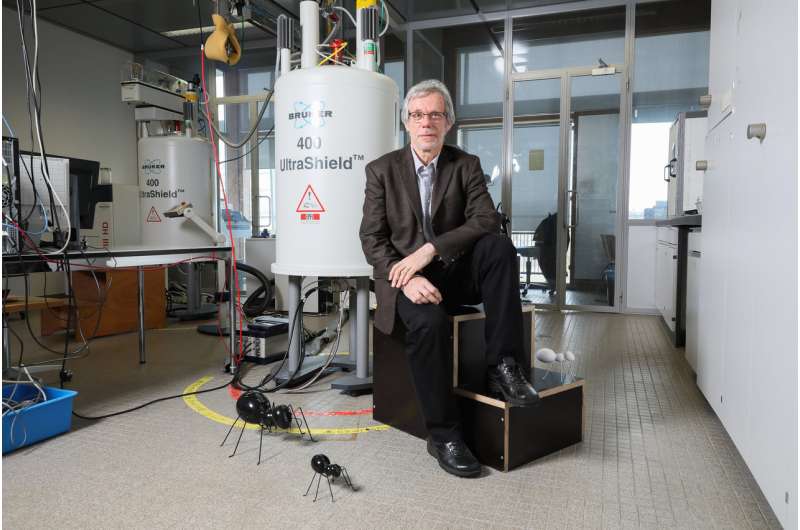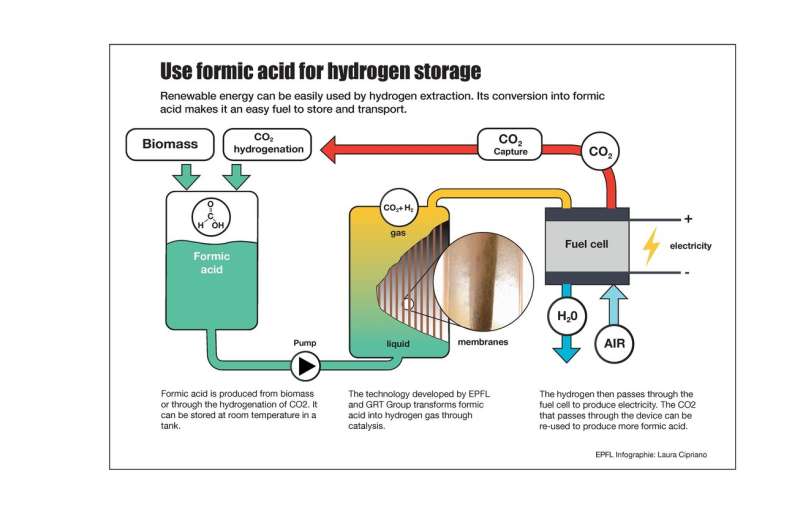Team creates the world's first formic acid-based fuel cell

Clean energy costs will be equal or less than fossil fuels by 2020, while renewable energy sources will meet 40 percent of global energy demand by 2040. But because renewable energy depends on the sun and wind, it is still largely unreliable. Therefore, the challenge is to develop new methods for storing renewable energy surplus in a way that allows it to be used when needed.
This is the aim of the HYFORM-PEMFC project carried out by GRT Group, a company that focuses on energy transition with energy-storage development solutions, and Professor Gabor Laurenczy's research group at EPFL, who have developed a new, integrated formic acid-hydrogen fuel cell device.
The HYFORM-PEMFC device uses formic acid to store hydrogen, and has domestic and industrial applications. Compared to devices that only use hydrogen, the HYFORM-PEMFC has been designed to ensure substantial benefits in terms of size (1 liter of formic acid carries 590 liters of hydrogen), ease of transportation, safety, and lower operating costs while being environmentally sustainable.
The potential users of the HYFORM-PEMFC include those in areas with limited or no access to the power grid, and those who develop hydrogen transport systems. The unit can supply an alpine chalet with heat and electricity easily and with environmentally friendly refueling. The technology can be also be scaled up to meet the power needs of larger settings, such as industrial plants.
"This is an important milestone in our strategic plan for the development of energy storage applications," says GRT Group CEO Luca Dal Fabbro. "GRT Group wants to support the transition towards a fully renewable energy supply, and to thus address the global challenge of reducing CO2 emissions."
The next step for GRT Group is to develop a complete, integrated system for storing renewable energy, e.g. excess solar electricity produced during the summer, which can then be used to produce electricity and heat on demand in the winter, thus making buildings energetically autonomous. This project will prove the economic benefits of the concept and its real potential in an integrated energy storage system.

Hydrogen is one of the most promising energy carriers among renewable energy storage solutions. Using hydrogen to produce heat or electricity produces no carbon or particle emissions, meaning that it has no negative environmental impact. The problem is that hydrogen has a very low energy content by volume. This makes it very difficult to store and transport in its natural form (gas), or requiring very high pressures, very low temperatures, and expensive infrastructures, all of which translates into safety and cost concerns.
The alternative solution is to use a hydrogen carrier such as formic acid, which is the simplest combination of hydrogen and CO2. Formic acid is liquid at normal conditions, easy to store, transport, and handle, and is produced from sustainable sources in hundreds of thousands of tons globally: it is already used widely in agriculture and industry.
The challenge, then, is getting the stored hydrogen back out of the formic acid in an energy-efficient manner. This is where catalysts come in. These are compounds that facilitate the extraction of hydrogen from formic acid so that it can then be converted into electricity through a fuel cell.
The device consists of two main parts, a hydrogen reformer (HYFORM) and a proton-exchange membrane fuel cell (PEMFC). The HYFORM reformer uses a ruthenium-based catalyst to extract hydrogen, although the scientists are currently developing catalysts based on even cheaper materials.
The HYFORM-PEMFC unit can produce 7000 kWh yearly, and its nominal power is 800 Watts - roughly the equivalent of 200 smartphones being recharged simultaneously. Its electrical efficiency is currently up to 45 percent. As long as the formic acid used is produced sustainably, the fuel cell is completely environmentally friendly and allows long-term storage of renewable energy. It is quiet, emits clean gas, has zero carbon dioxide balance, and produces neither particles nor nitrogen oxides.
At the same time, the HYFORM-PEMFC is low-maintenance, needing no sulfur treatment, and features stable and long-term catalyst performance. Its technology is scalable, so it can be used in both households and industrial settings. Since it only needs to be fueled with formic acid, the system does not require connection to power grids, which makes it ideal for remote or inaccessible areas.
"The chemical transformation of CO2, a greenhouse gas, into useful products becomes increasingly important as its atmosphere levels continue to rise because of human activity," says Gabor Laurenczy. "For this reason, producing formic acid in a sustainable way - using CO2 as a hydrogen-energy vector - is very important. Worldwide demand for formic acid is growing, especially in the context of renewable energy. Hydrogen carriers, and their production from CO2, either through hydrogenation or from bio-waste or biomass, are considerably more sustainable than existing routes."
Provided by Ecole Polytechnique Federale de Lausanne



















